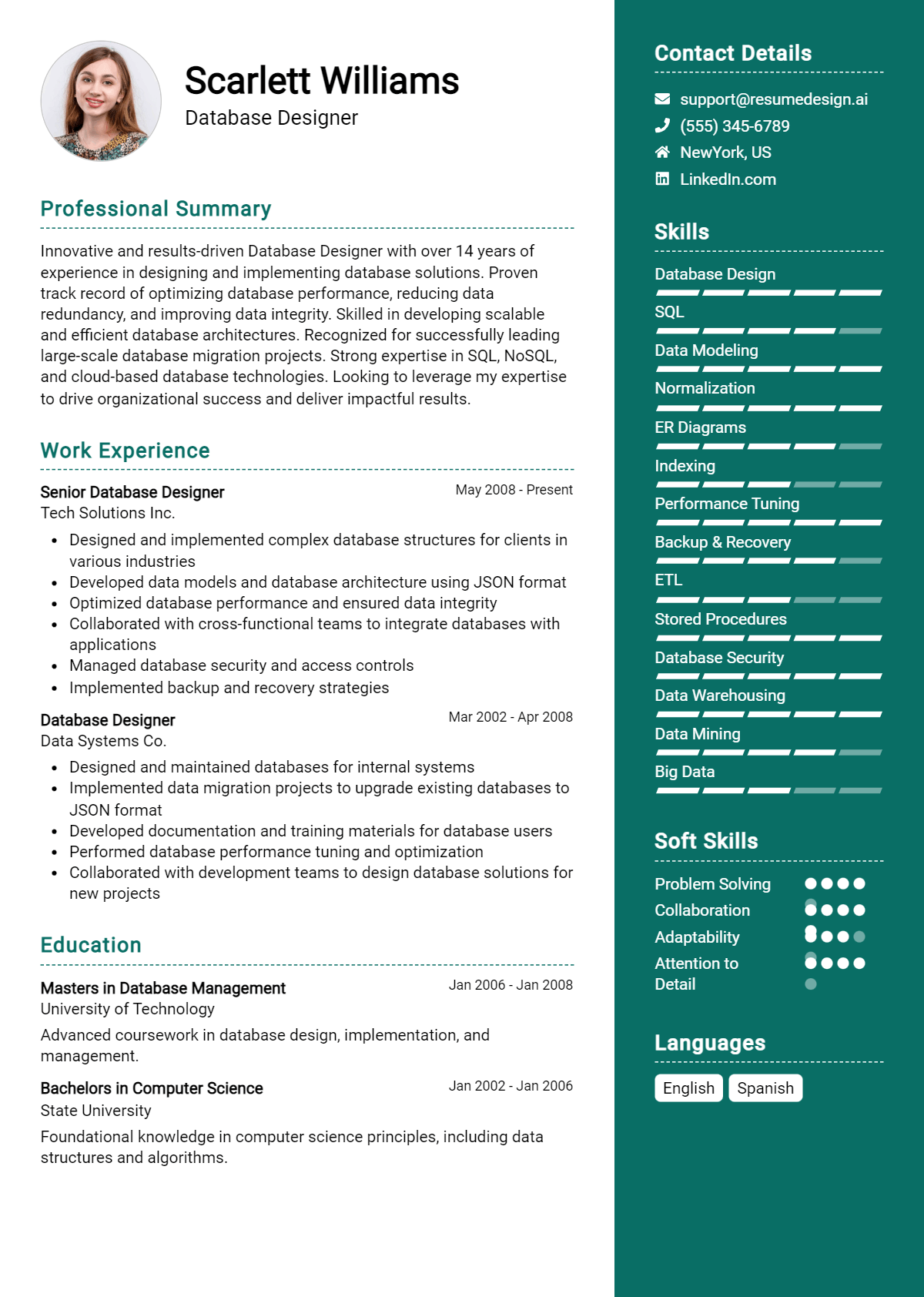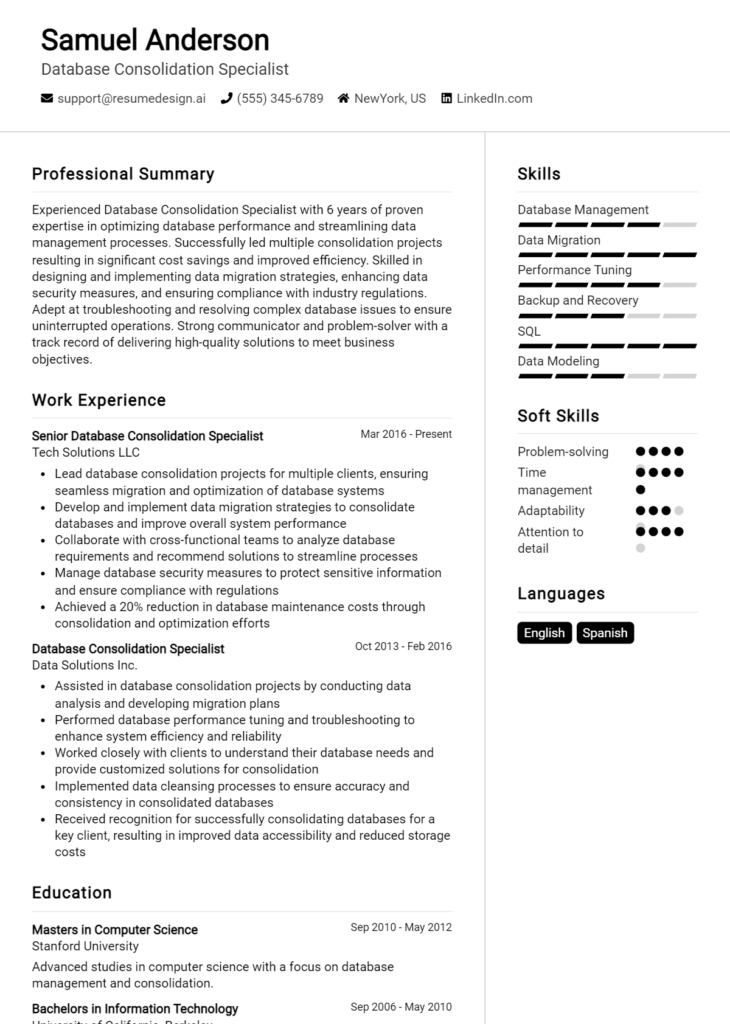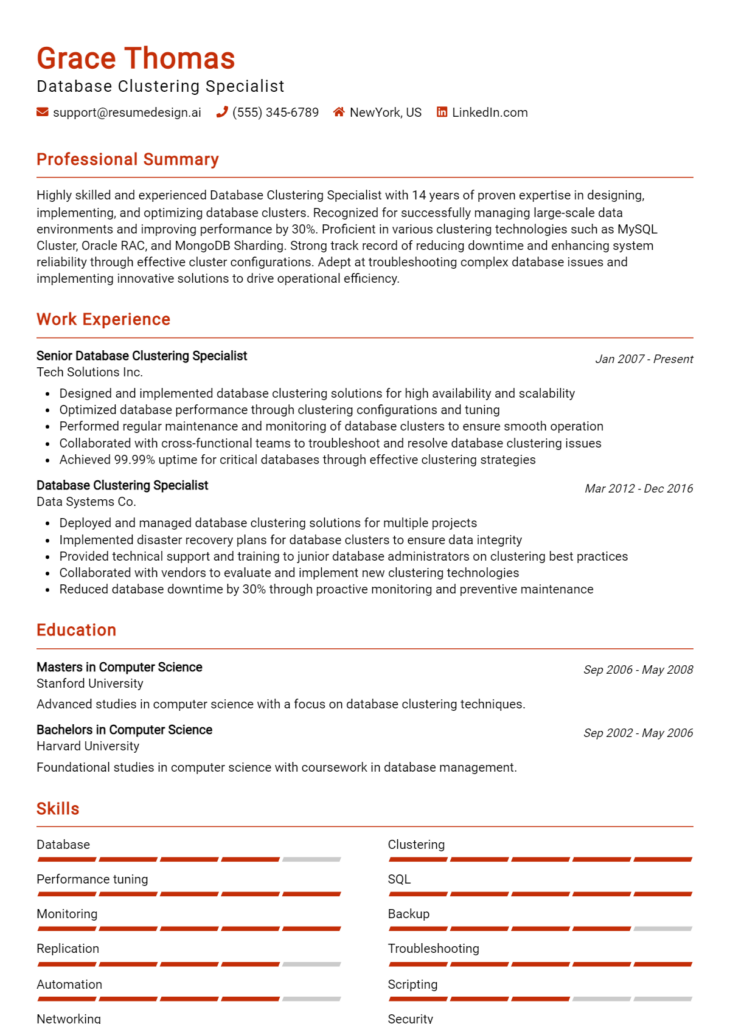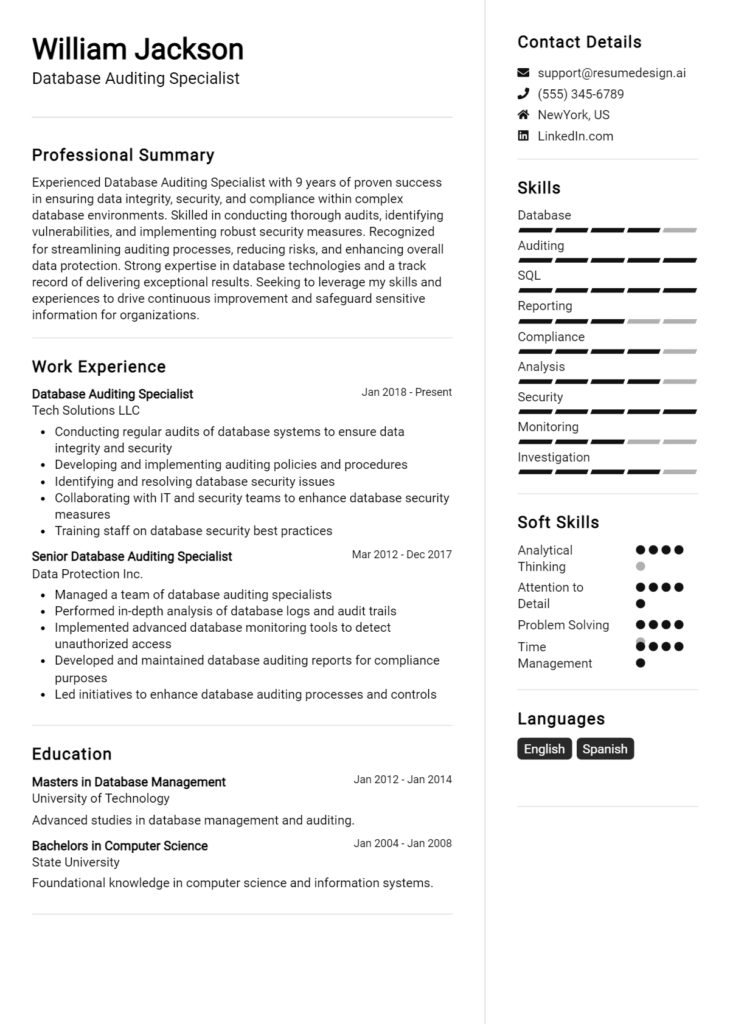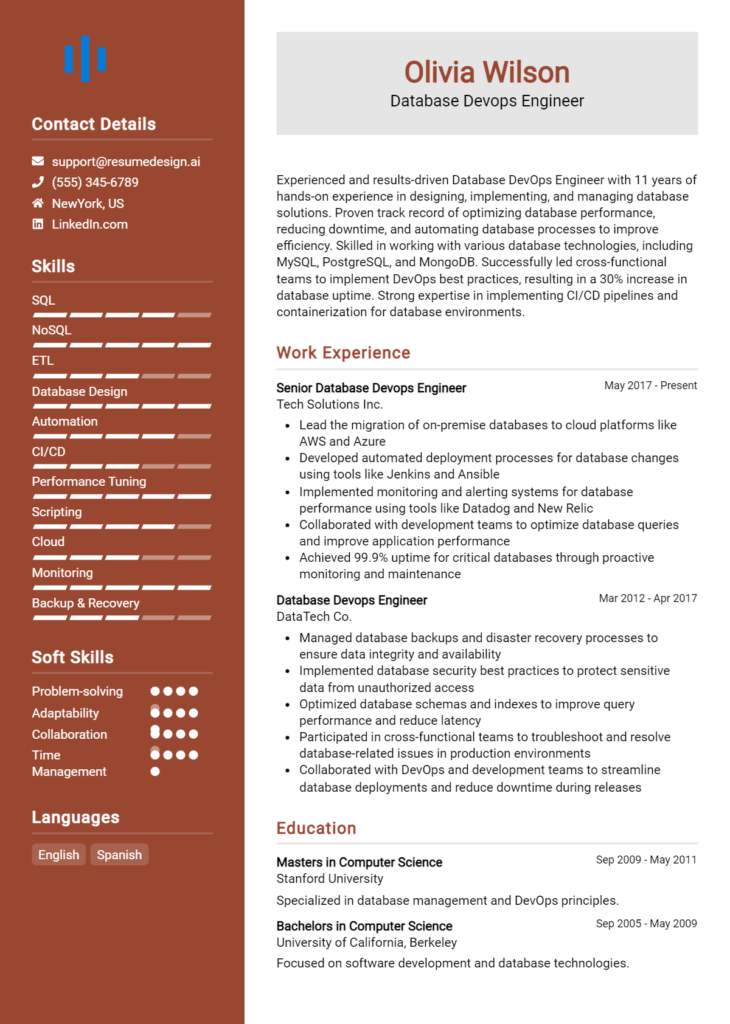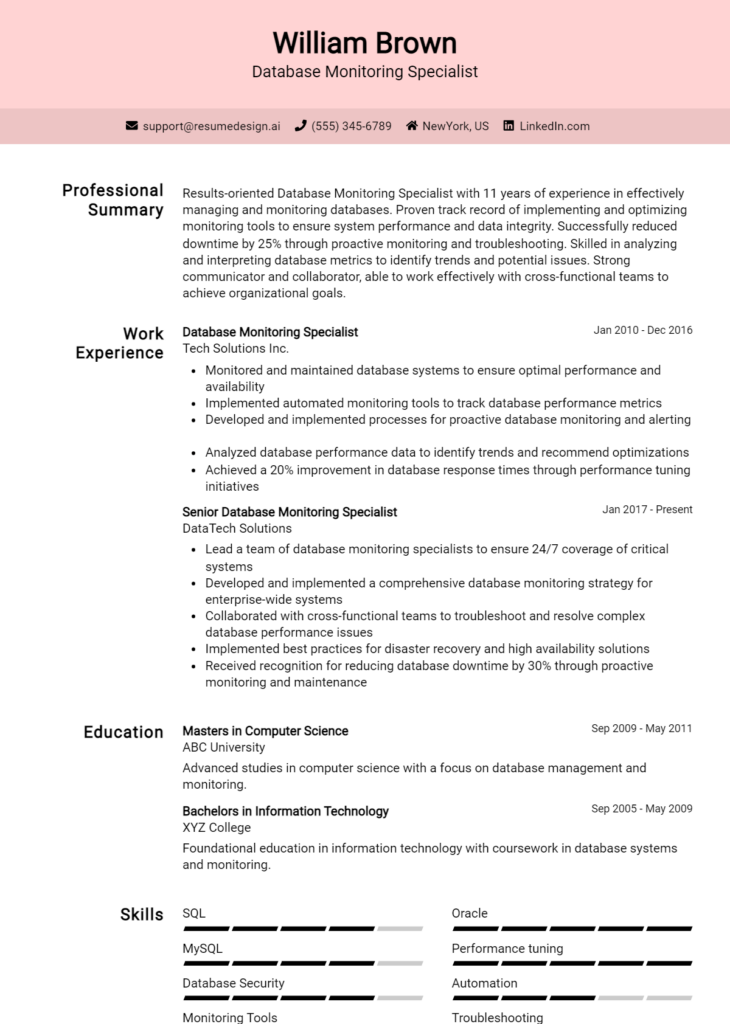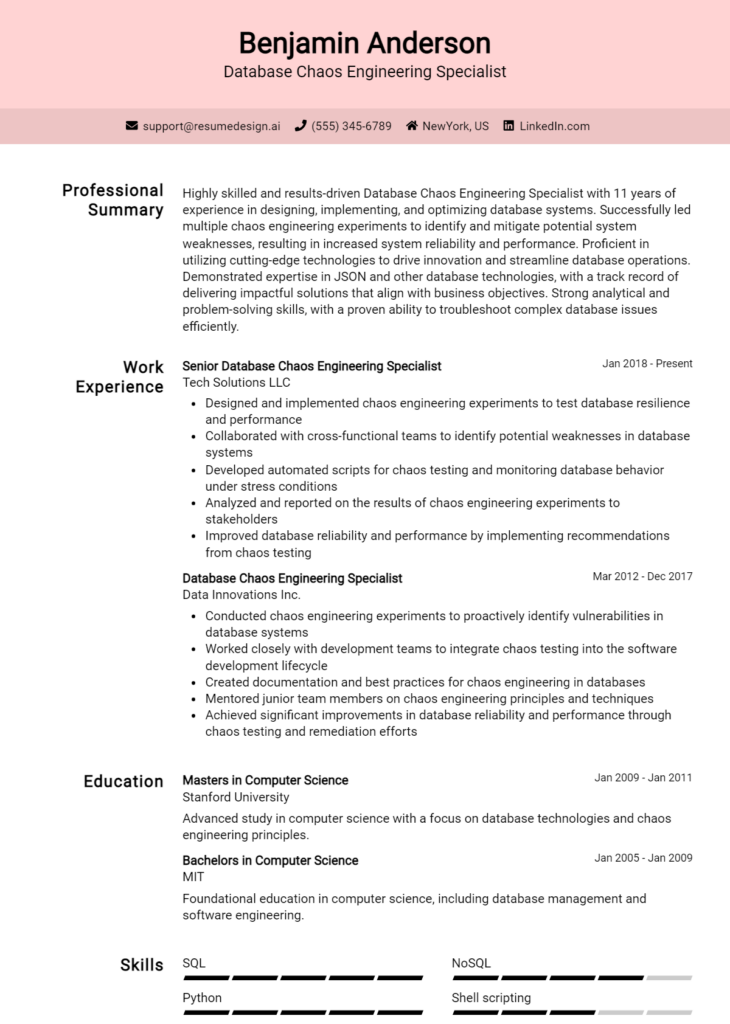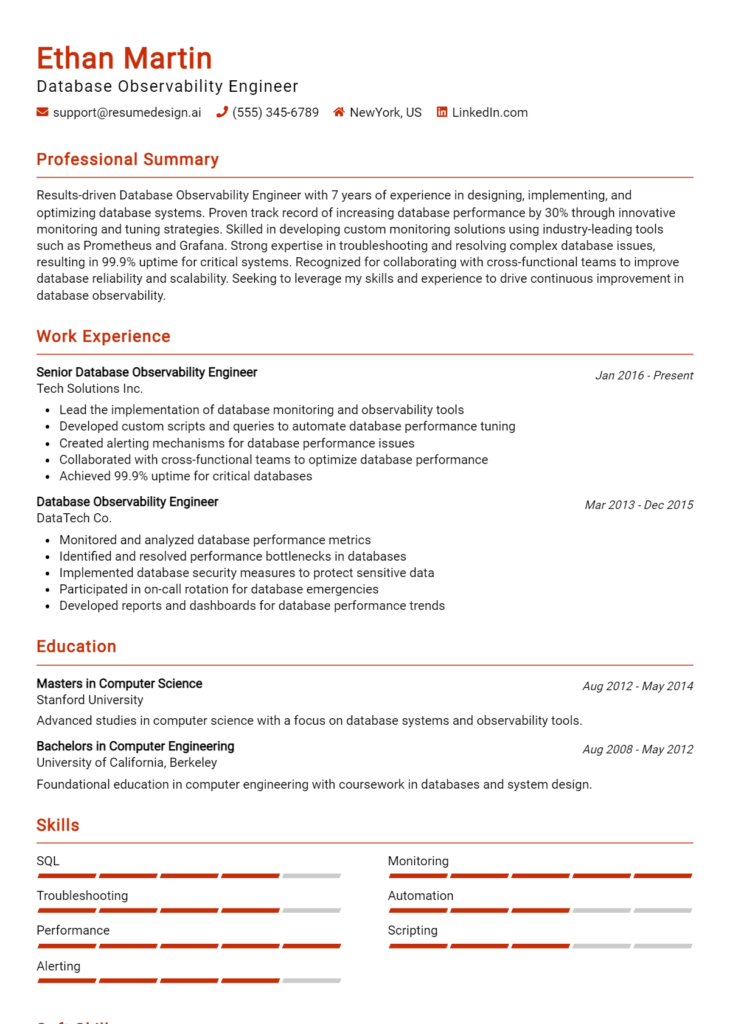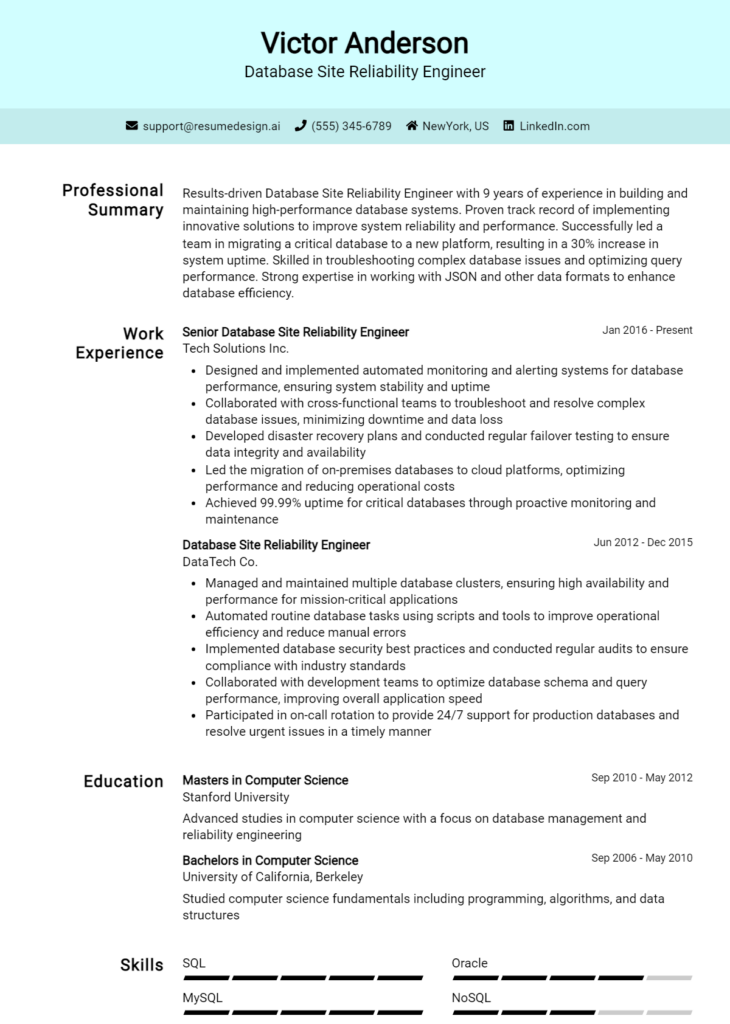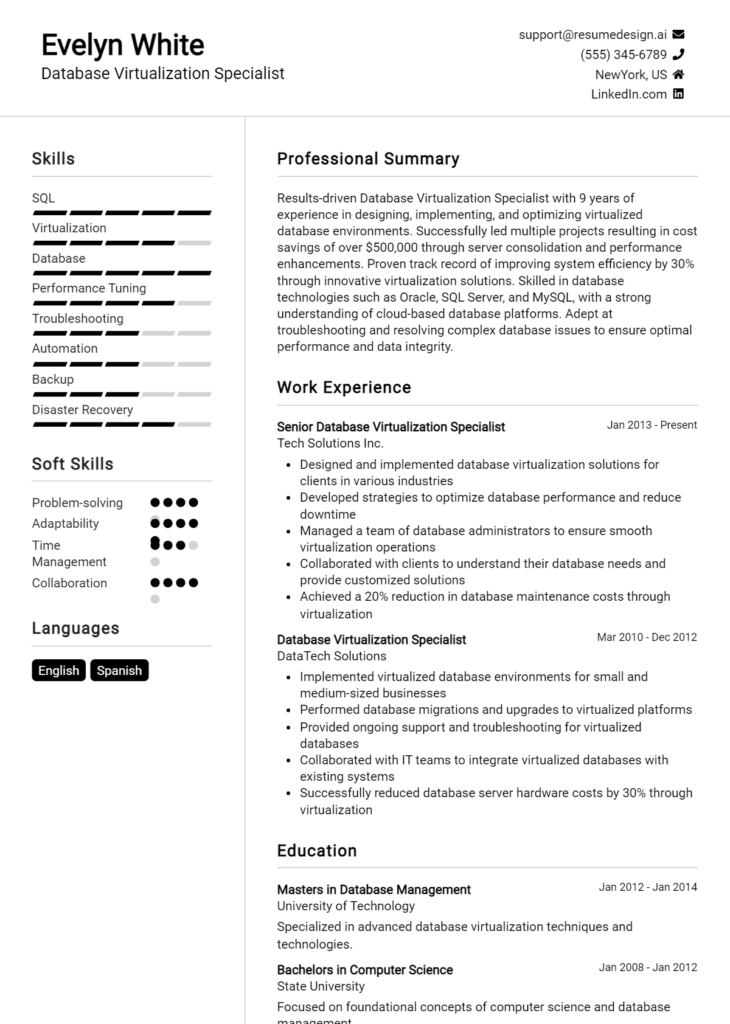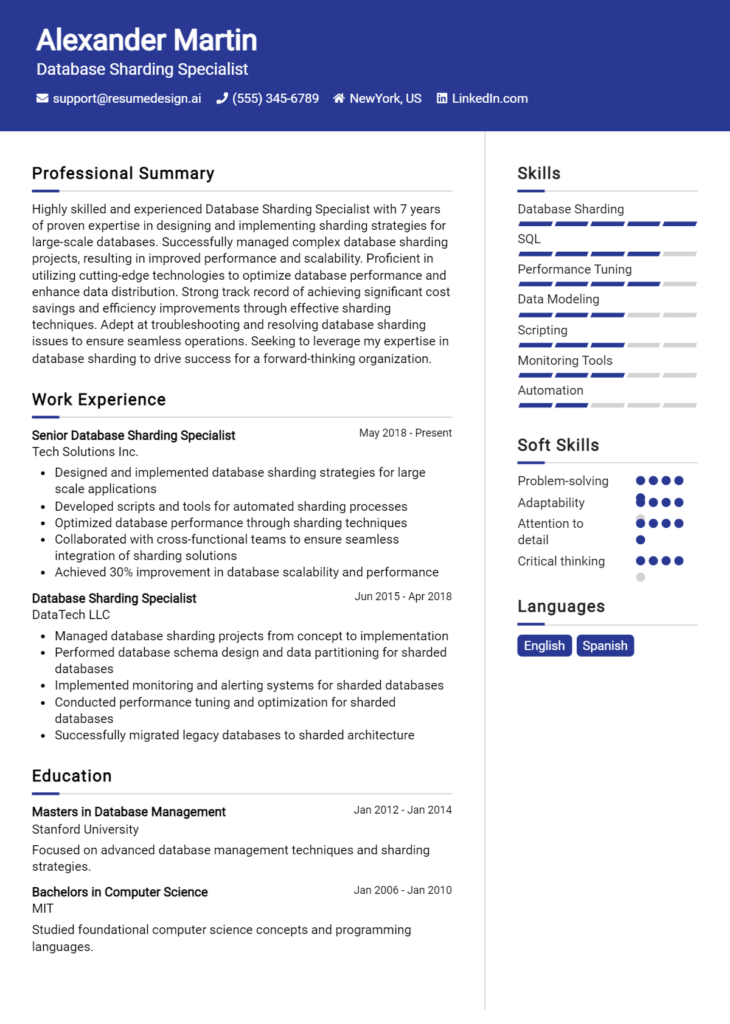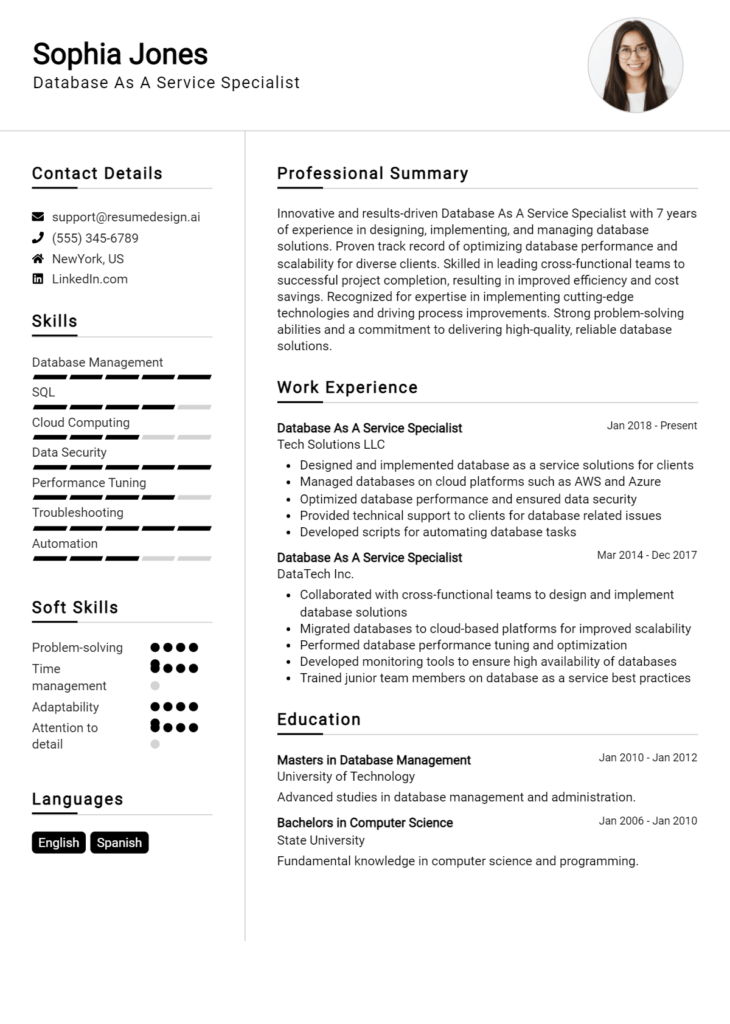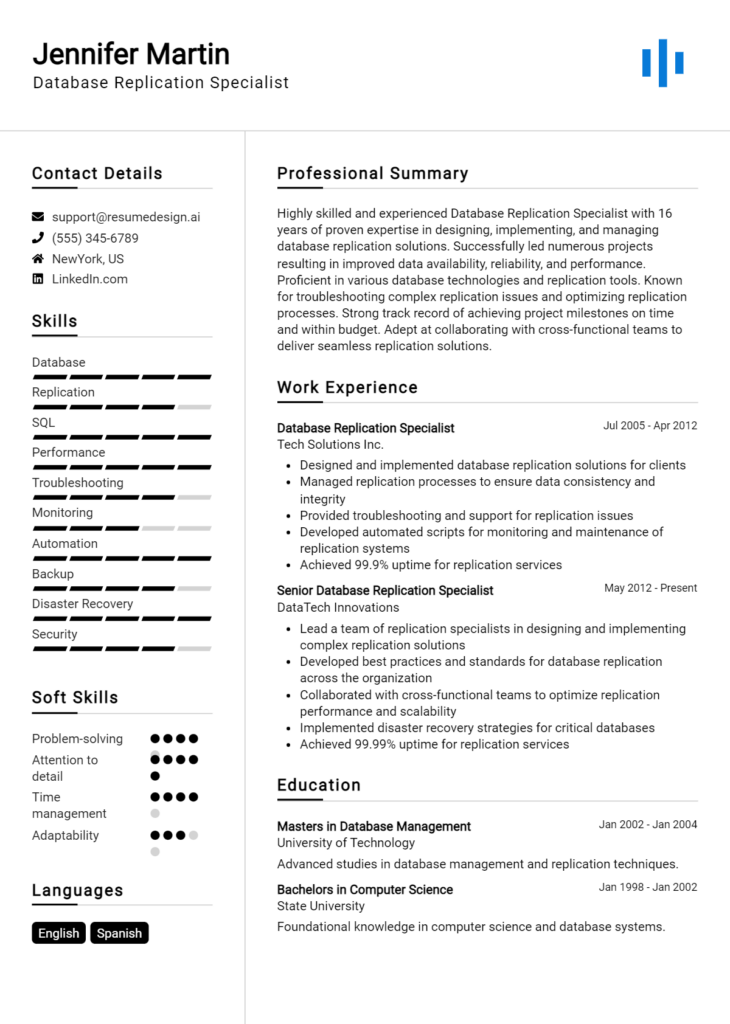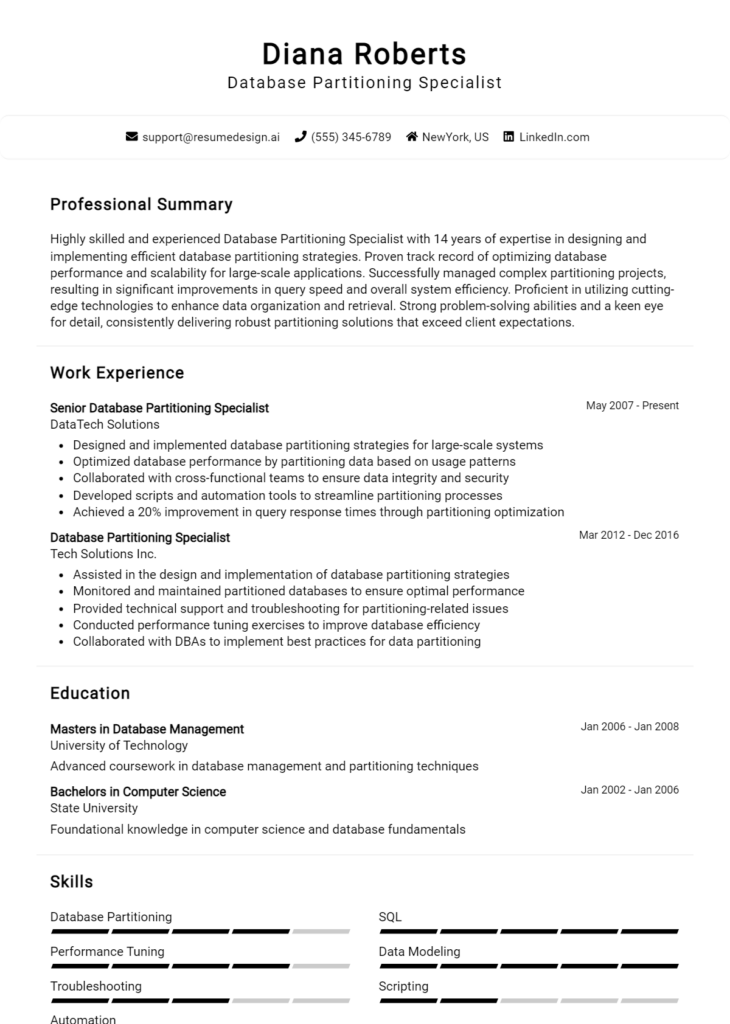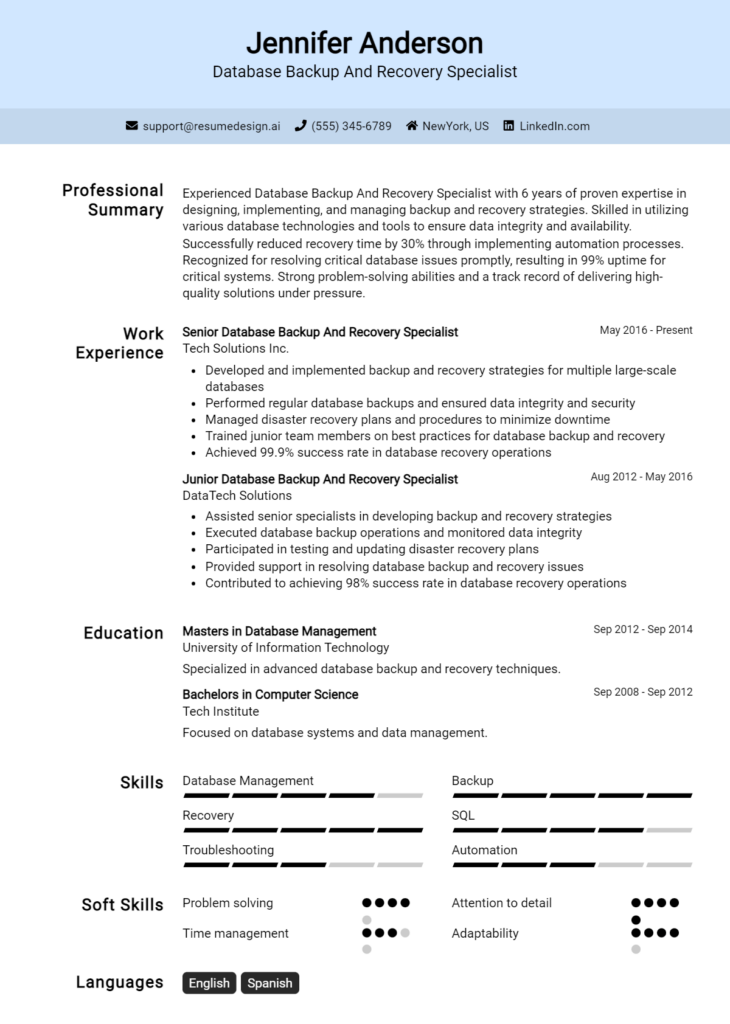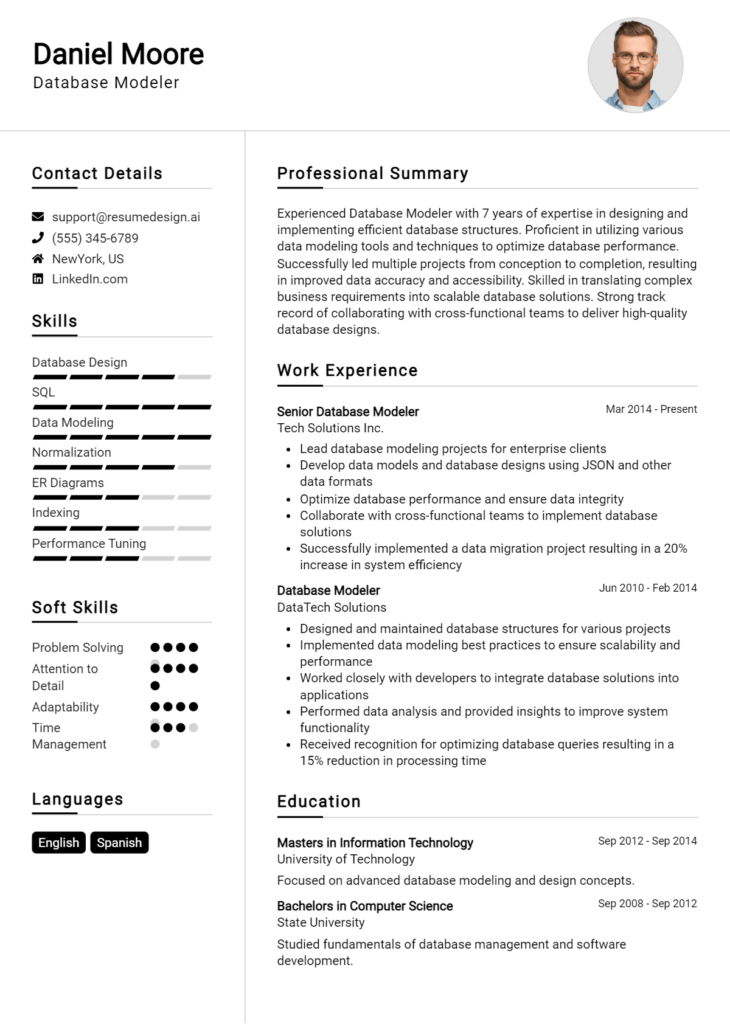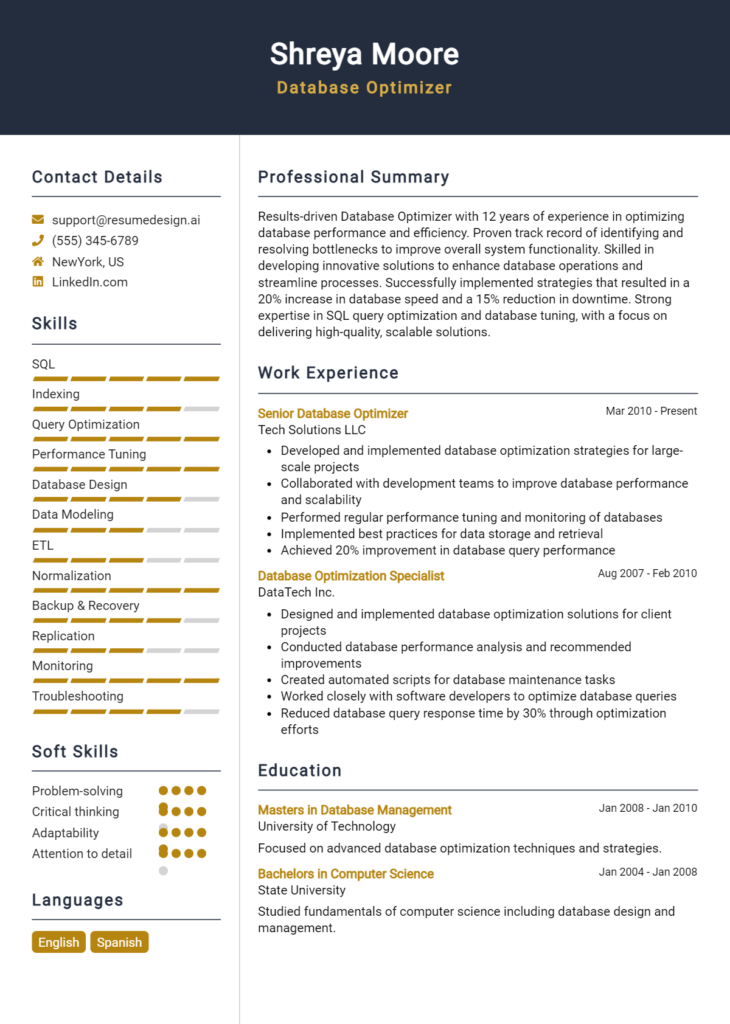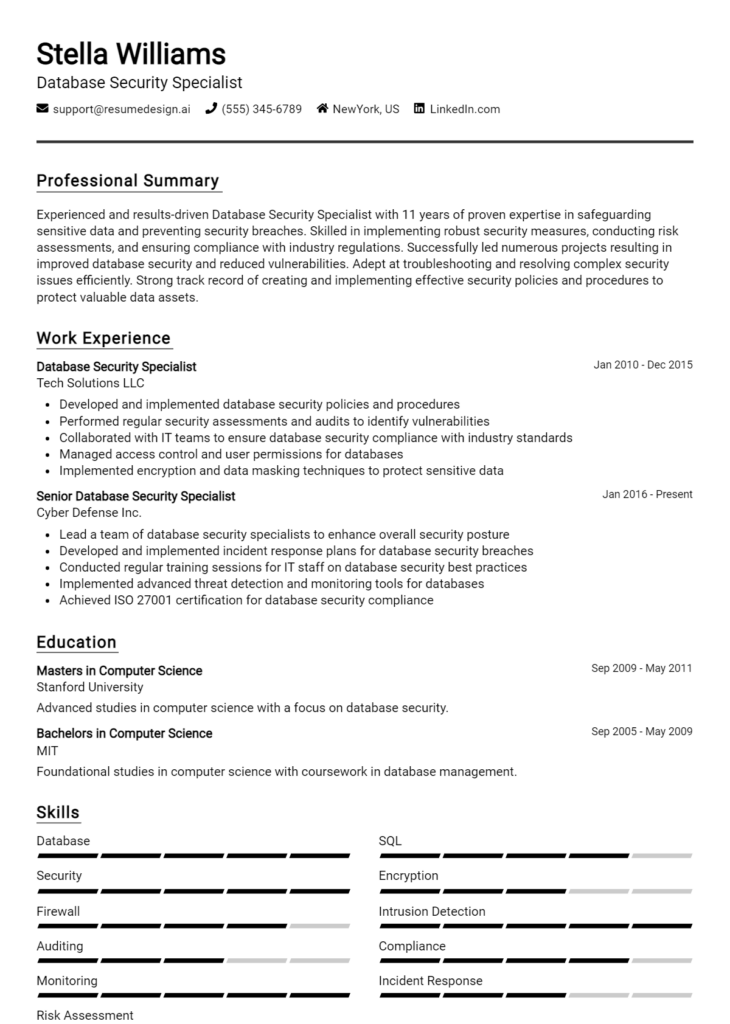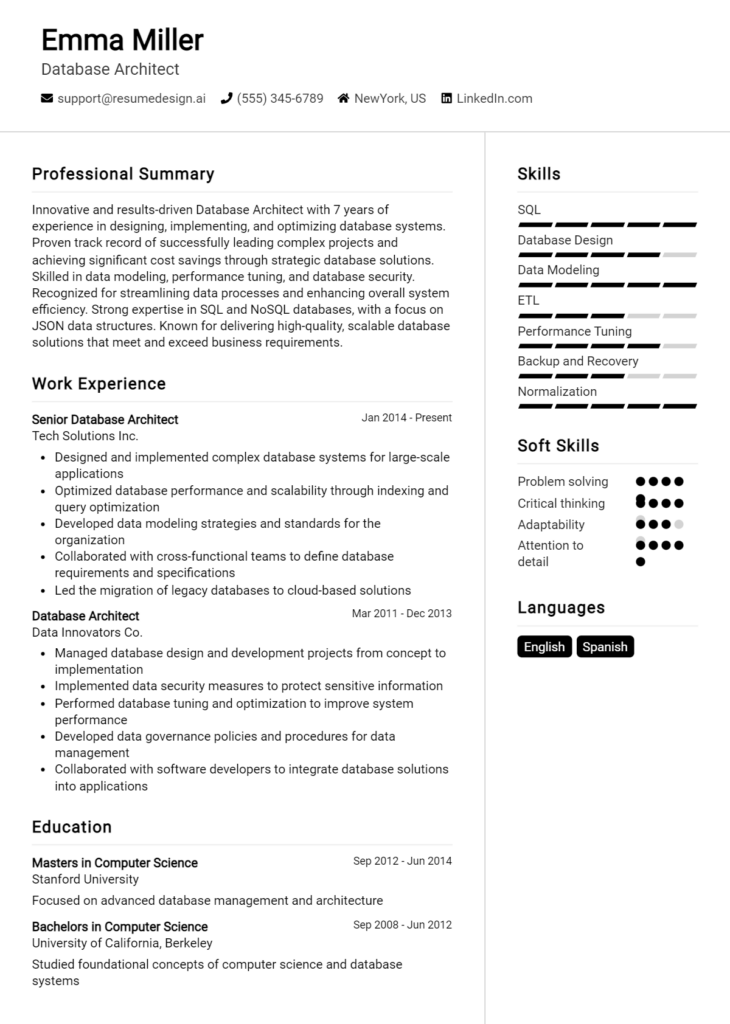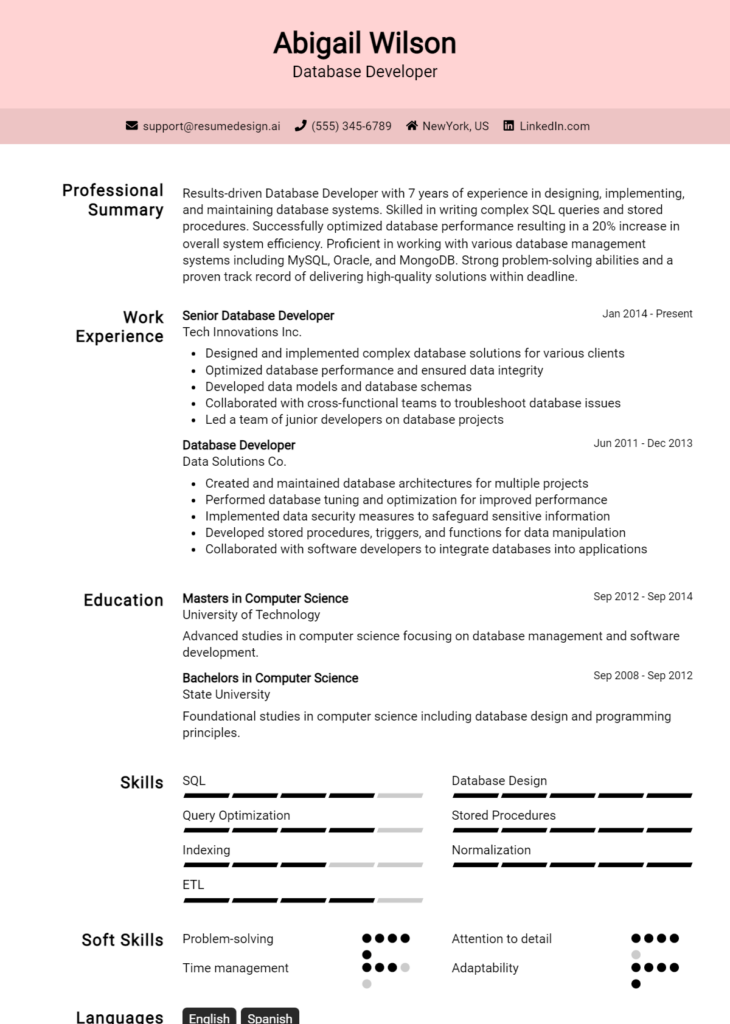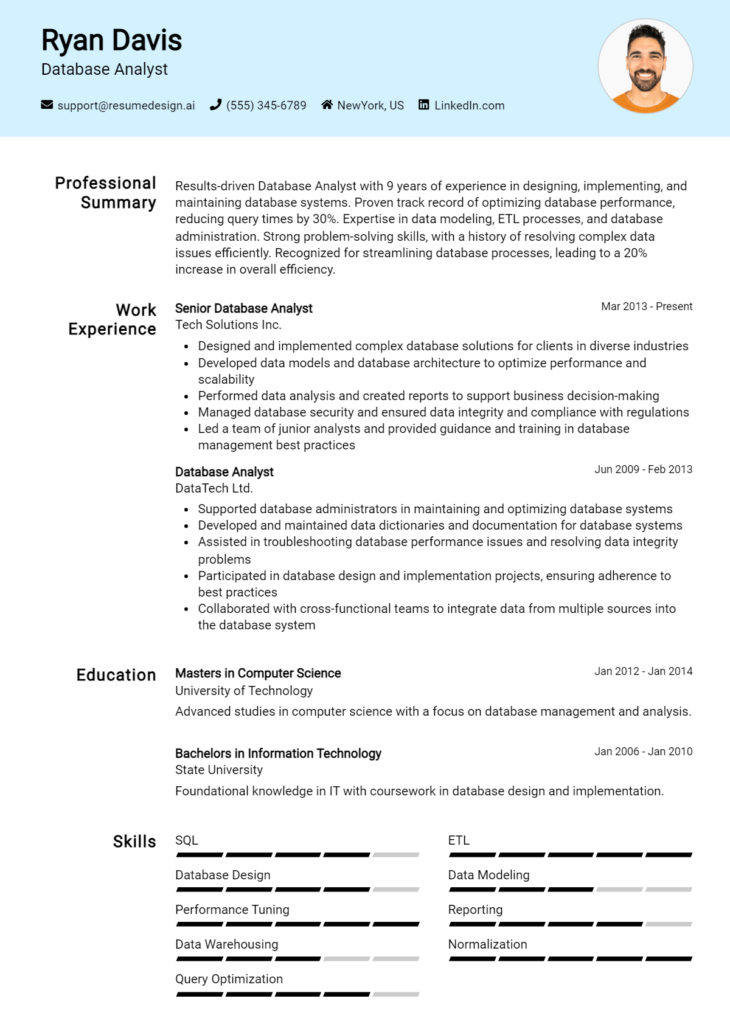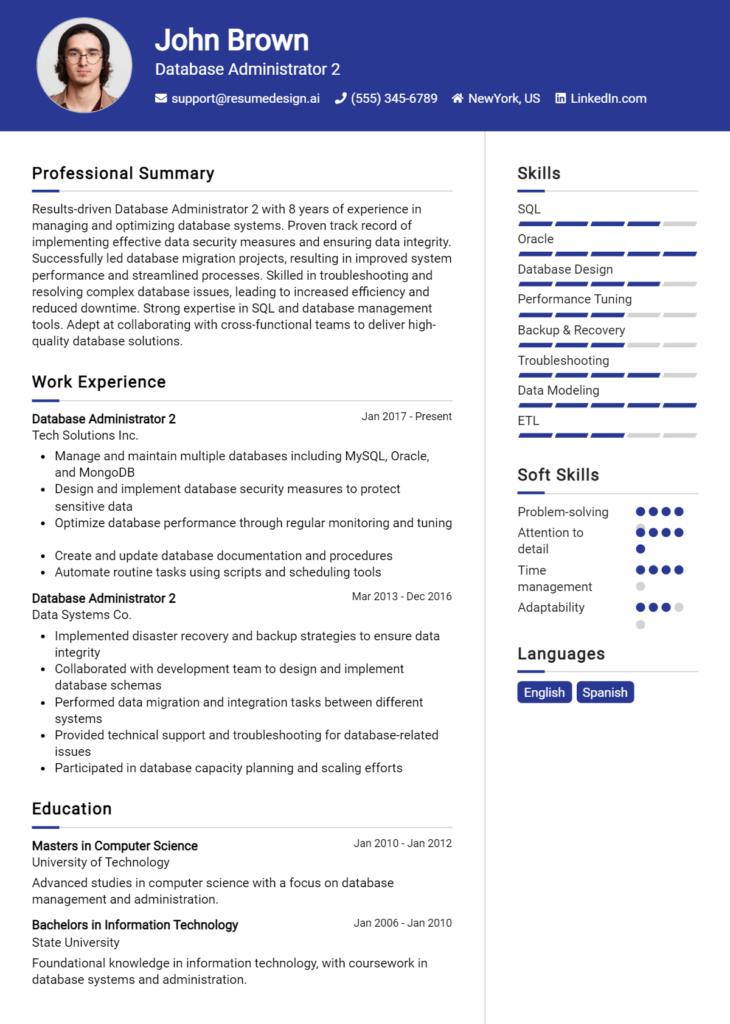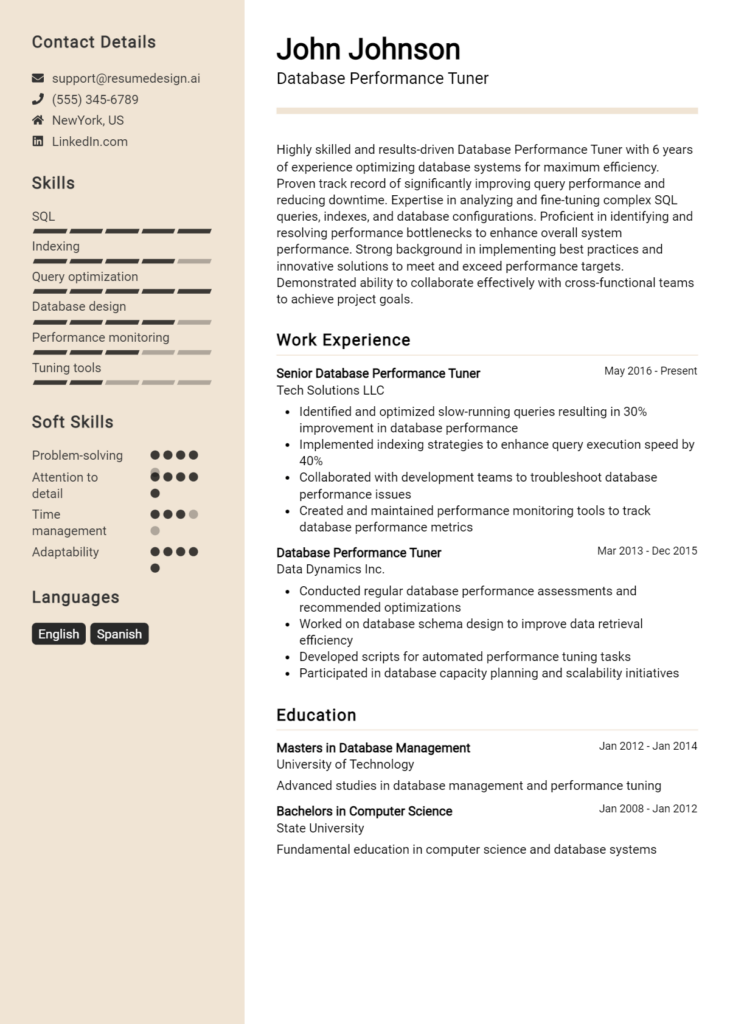Database Designer Core Responsibilities
A Database Designer plays a crucial role by collaborating across various departments to develop efficient database systems that meet organizational needs. Key responsibilities include designing database architecture, ensuring data integrity, and optimizing performance. Essential skills encompass technical expertise in database management systems, operational efficiency, and strong problem-solving abilities. These qualifications are vital for supporting the organization's objectives. A well-structured resume effectively highlights these competencies, showcasing a candidate's potential to contribute significantly to the team.
Common Responsibilities Listed on Database Designer Resume
- Design and implement database structures and models.
- Conduct data analysis to inform database development.
- Ensure data integrity and security protocols are in place.
- Optimize database performance through tuning and indexing.
- Collaborate with developers and stakeholders to gather requirements.
- Create and maintain documentation for database systems.
- Monitor and troubleshoot database issues.
- Develop backup and recovery strategies.
- Implement data migration processes as needed.
- Stay updated on database technologies and best practices.
- Train and support users on database functionalities.
High-Level Resume Tips for Database Designer Professionals
A well-crafted resume is an essential tool for Database Designer professionals, serving as the first impression a candidate makes on potential employers. In a competitive job market, your resume must effectively reflect not only your technical skills but also your achievements in the field. It is crucial to present a clear narrative of your expertise in database architecture, design, and management, as this can significantly influence hiring decisions. This guide will provide practical and actionable resume tips specifically tailored for Database Designer professionals, ensuring that you stand out in the applicant pool.
Top Resume Tips for Database Designer Professionals
- Tailor your resume to match the job description by incorporating relevant keywords and phrases.
- Highlight your experience with different database management systems (DBMS) such as MySQL, Oracle, or SQL Server.
- Quantify your achievements by including metrics, such as performance improvements or cost savings resulting from your database designs.
- Showcase your understanding of data modeling concepts, including normalization and denormalization techniques.
- Include any certifications or training related to database design and management, such as Microsoft Certified Database Administrator.
- Describe your proficiency in SQL and other query languages, providing examples of complex queries you have written.
- Emphasize your collaborative skills by detailing your experience working with cross-functional teams, such as developers and data analysts.
- List any experience with data warehousing or business intelligence tools that complement your database design skills.
- Keep your format clean and professional, using bullet points and headings for easy readability.
- Regularly update your resume to reflect your latest projects and accomplishments in the database field.
By implementing these tips, you can significantly increase your chances of landing a job in the Database Designer field. A polished and tailored resume will not only highlight your technical expertise but also showcase your achievements, making you a compelling candidate for potential employers. Take the time to craft a resume that truly represents your skills and experiences, and watch as new opportunities unfold.
Why Resume Headlines & Titles are Important for Database Designer
In the competitive landscape of job applications, a well-crafted resume headline or title serves as a crucial element for Database Designers. These succinct phrases have the power to immediately capture the attention of hiring managers, summarizing a candidate's key qualifications in a single impactful statement. A strong headline not only highlights the applicant's skills and experiences but also aligns them with the specific requirements of the job being applied for. Therefore, it is essential that the headline is concise, relevant, and clearly indicative of the candidate's expertise in database design, ensuring they stand out in a sea of applicants.
Best Practices for Crafting Resume Headlines for Database Designer
- Keep it concise: Aim for a headline that is brief yet descriptive, ideally no more than 10-12 words.
- Be role-specific: Tailor your headline to reflect the specific position you are applying for, such as "Senior Database Designer" or "Database Architect."
- Highlight core competencies: Include key skills or technologies relevant to database design, such as SQL, NoSQL, or data modeling.
- Showcase experience level: Indicate your years of experience or expertise level, e.g., "Experienced Database Designer with 5+ Years in Data Warehousing."
- Incorporate measurable achievements: If possible, reference specific accomplishments, such as "Innovative Database Designer with a Track Record of 30% Performance Improvement."
- Avoid jargon: Use clear and straightforward language that can be easily understood by hiring managers.
- Stay relevant: Ensure your headline aligns with current industry trends and the specific requirements of the job posting.
- Use keywords: Incorporate relevant keywords from the job description to enhance visibility in applicant tracking systems (ATS).
Example Resume Headlines for Database Designer
Strong Resume Headlines
"Data-Driven Database Designer Specializing in High-Performance Systems"
"Innovative Database Architect with Expertise in Big Data Solutions"
"Experienced SQL Database Designer with Proven Track Record in Optimization"
"Results-Oriented Database Designer with 7 Years of Experience in Data Management"
Weak Resume Headlines
“Database Designer”
“Professional with Database Skills”
Strong resume headlines are effective because they are specific, targeted, and convey a clear message about the candidate's qualifications and expertise. They immediately provide hiring managers with insight into the applicant's potential contributions to the organization. In contrast, weak headlines fail to impress as they lack specificity and do not highlight the candidate’s unique strengths or experiences, making it difficult for employers to gauge the applicant's suitability for the role.
Writing an Exceptional Database Designer Resume Summary
A well-crafted resume summary is crucial for a Database Designer, as it serves as the first impression for hiring managers. This brief yet impactful section is designed to quickly capture attention by showcasing key skills, relevant experience, and notable accomplishments that align with the job role. A strong summary not only highlights what makes the candidate unique but also sets the tone for the rest of the resume. It should be concise, impactful, and tailored specifically to the job the candidate is applying for, ensuring that it resonates with the expectations of potential employers.
Best Practices for Writing a Database Designer Resume Summary
- Quantify Achievements: Use numbers to demonstrate the impact of your work, such as "Reduced database retrieval time by 30%."
- Focus on Skills: Highlight technical skills relevant to database design, such as SQL proficiency, data modeling, and performance tuning.
- Tailor for the Job Description: Customize your summary to align with the specific requirements and keywords listed in the job posting.
- Showcase Relevant Experience: Summarize your most pertinent work history or projects that directly relate to database design.
- Keep it Concise: Aim for 2-4 sentences that deliver maximum information with clarity.
- Use Action Verbs: Start your sentences with strong action verbs to convey confidence and proactivity.
- Highlight Certifications: If applicable, mention any relevant certifications that enhance your qualifications as a Database Designer.
- Convey Passion: Express enthusiasm for database design and technology, as it can set you apart from other candidates.
Example Database Designer Resume Summaries
Strong Resume Summaries
Dynamic Database Designer with over 6 years of experience optimizing systems for Fortune 500 companies, achieving a 40% increase in data retrieval efficiency through innovative schema design and indexing strategies.
Results-driven Database Designer skilled in SQL, NoSQL, and data warehousing, successfully led a team that migrated 2 million records to a new platform, decreasing downtime by 50% and improving data accessibility.
Detail-oriented Database Designer with a track record of delivering high-quality database solutions, including a recent project that enhanced reporting speed by 35% through effective normalization techniques.
Creative Database Designer with an extensive background in cloud-based database management, adept at developing scalable solutions that support 500+ concurrent users, thus improving user satisfaction ratings by 25%.
Weak Resume Summaries
Experienced database designer looking for a job in a company.
Knowledgeable in databases and looking to contribute to a team.
The examples of strong resume summaries are considered effective because they provide specific achievements, quantify results, and directly relate to the skills and experience required for the role of a Database Designer. In contrast, the weak resume summaries are vague and generic, lacking quantifiable outcomes or clear relevance to the job, making them less likely to capture the attention of hiring managers.
Work Experience Section for Database Designer Resume
The work experience section of a Database Designer resume is a vital component that highlights the candidate's technical skills, project management capabilities, and success in delivering high-quality database solutions. This section not only showcases the practical application of database design principles but also demonstrates the ability to work collaboratively with cross-functional teams. By quantifying achievements and aligning experiences with industry standards, candidates can effectively illustrate their impact and expertise in the field, making them more attractive to potential employers.
Best Practices for Database Designer Work Experience
- Focus on specific technical skills related to database design, such as SQL, normalization, and data modeling.
- Quantify achievements with metrics, such as performance improvements, database scalability, or reduced load times.
- Highlight leadership roles in projects or teams to demonstrate management capabilities.
- Include collaboration experiences with software developers, data analysts, and other stakeholders.
- Use action verbs to convey proactive contributions, such as "designed," "implemented," or "optimized."
- Tailor work experience descriptions to align with job postings and industry standards.
- Showcase problem-solving skills by describing challenges faced and solutions implemented.
- Include relevant certifications or training that enhance technical expertise.
Example Work Experiences for Database Designer
Strong Experiences
- Led a team of 5 in designing a high-availability database architecture that improved uptime by 30%, resulting in a 20% increase in customer satisfaction.
- Developed and implemented a data warehousing solution that decreased reporting time by 50%, enabling timely business decisions.
- Collaborated with cross-functional teams to migrate legacy systems to a new SQL database, reducing operational costs by 15% annually.
- Optimized existing database queries, improving performance by 40% and significantly enhancing application responsiveness.
Weak Experiences
- Worked on database projects that involved some design.
- Assisted in team meetings to discuss database issues.
- Involved in data entry and basic database maintenance tasks.
- Helped with some database-related documentation.
The examples above illustrate why certain experiences are considered strong or weak. Strong experiences are characterized by clear, quantifiable outcomes and demonstrate technical leadership and collaboration, showcasing the candidate's direct impact on project success. In contrast, weak experiences tend to be vague and lack specific achievements, making it difficult to assess the candidate's true capabilities and contributions to past roles.
Education and Certifications Section for Database Designer Resume
The education and certifications section of a Database Designer resume plays a crucial role in showcasing the candidate's academic qualifications and commitment to professional development. This section not only highlights the foundational knowledge acquired through formal education but also emphasizes industry-relevant certifications that validate the candidate's skills and expertise. By detailing relevant coursework and specialized training, candidates can enhance their credibility and demonstrate their alignment with the requirements of the job role, making them more attractive to potential employers.
Best Practices for Database Designer Education and Certifications
- Include relevant degrees such as Computer Science, Information Systems, or Database Management.
- List industry-recognized certifications like Microsoft Certified: Azure Database Administrator Associate or Oracle Certified Professional.
- Highlight specific coursework related to database design, data modeling, and SQL.
- Use clear formatting to separate educational institutions and dates attended.
- Incorporate any specialized training or workshops that enhance database design skills.
- Prioritize certifications that demonstrate current knowledge of database technologies.
- Keep the information up-to-date to reflect the most recent educational achievements and certifications.
- Consider including online courses or boot camps that are relevant to database design.
Example Education and Certifications for Database Designer
Strong Examples
- Bachelor of Science in Computer Science, University of XYZ, Graduated May 2021
- Microsoft Certified: Azure Database Administrator Associate, Issued June 2022
- Relevant Coursework: Advanced Database Design, Data Warehousing, and SQL Programming
- Postgraduate Certificate in Data Science, ABC Institute, Completed December 2023
Weak Examples
- Associate Degree in General Studies, Community College of ABC, Graduated May 2019
- Certificate in Microsoft Office, Issued April 2020
- High School Diploma, XYZ High School, Graduated June 2017
- Outdated Certification in Oracle 11g, Issued January 2015
The examples considered strong reflect directly relevant educational qualifications and certifications that align with the skills and knowledge required in database design roles. They emphasize recent achievements and specialized training that demonstrate a commitment to continuous learning. In contrast, the weak examples are less relevant to the position; they include outdated certifications and degrees that do not focus on database design or are too general, failing to showcase the candidate's readiness for the specific demands of the role.
Top Skills & Keywords for Database Designer Resume
As a Database Designer, possessing the right skills is crucial for creating efficient and effective database systems. A well-crafted resume that highlights both hard and soft skills can make a significant difference in standing out to potential employers. Hard skills demonstrate your technical proficiency and knowledge of database management, while soft skills reflect your ability to communicate, collaborate, and solve problems within a team. Together, these skills not only showcase your qualifications but also your suitability for the role, ensuring that you can contribute to the success of an organization.
Top Hard & Soft Skills for Database Designer
Soft Skills
- Problem-solving
- Attention to detail
- Communication skills
- Team collaboration
- Adaptability
- Time management
- Critical thinking
- Analytical skills
- Creativity
- Conflict resolution
- Interpersonal skills
- Project management
Hard Skills
- SQL proficiency
- Database modeling
- Data warehousing
- Performance tuning
- ETL (Extract, Transform, Load) processes
- NoSQL databases
- Data security and compliance
- Database design principles
- Backup and recovery techniques
- Cloud database technologies
- Understanding of data governance
- Familiarity with database management systems (DBMS)
- Scripting languages (e.g., Python, Bash)
- Data visualization tools
For more insights on how to effectively highlight your skills and work experience, ensure your resume reflects the unique capabilities you bring to the table as a Database Designer.
Stand Out with a Winning Database Designer Cover Letter
Dear [Hiring Manager's Name],
I am writing to express my interest in the Database Designer position at [Company Name], as advertised on [where you found the job posting]. With a robust background in database architecture and a passion for optimizing data management systems, I am confident in my ability to contribute effectively to your team. My experience includes designing and implementing efficient database solutions that enhance data accessibility and integrity while supporting the overall goals of the organization.
In my previous role at [Previous Company Name], I successfully led a project to redesign the database structure for a large-scale application, which resulted in a 30% improvement in query performance and a significant reduction in data redundancy. I utilized my expertise in SQL, data modeling, and normalization techniques to create a scalable and efficient database schema that met the evolving needs of the business. My ability to collaborate with cross-functional teams, including developers and business analysts, ensured that the database design aligned with user requirements and industry standards.
I am particularly drawn to [Company Name] because of its commitment to leveraging innovative technologies to enhance data-driven decision-making. I am eager to bring my skills in database design and my proactive problem-solving approach to your organization. I am excited about the opportunity to work with a talented team and contribute to projects that have a meaningful impact on your business and customers.
Thank you for considering my application. I look forward to the opportunity to discuss how my background and skills can benefit [Company Name]. I am enthusiastic about the possibility of being part of your team and contributing to the continued success of your data management initiatives.
Sincerely,
[Your Name]
[Your LinkedIn Profile] (if applicable)
[Your Contact Information]
Common Mistakes to Avoid in a Database Designer Resume
When crafting a resume as a Database Designer, it's crucial to present your skills and experiences effectively to stand out in a competitive job market. However, many candidates often overlook key elements that can hinder their chances of landing an interview. Understanding and avoiding these common mistakes can significantly enhance the quality of your resume and showcase your qualifications more compellingly. Here are some common pitfalls to watch out for:
Neglecting to Tailor the Resume: Failing to customize your resume for the specific job application can make it seem generic. Highlight relevant skills and experiences that align with the job description.
Overloading with Technical Jargon: While technical expertise is essential, using excessive jargon can alienate hiring managers who may not have a deep technical background. Aim for clear and concise language that is accessible to a broader audience.
Ignoring Soft Skills: Database design is not solely about technical skills. Neglecting to include soft skills, such as teamwork, communication, and problem-solving, can make your resume appear one-dimensional.
Using a One-Size-Fits-All Format: A cluttered or overly complex resume format can be off-putting. Opt for a clean and professional layout that enhances readability and guides the reader’s eye.
Failing to Quantify Achievements: Simply listing responsibilities without quantifying accomplishments can diminish the impact of your experience. Use numbers and metrics to demonstrate the results of your work.
Listing Irrelevant Experience: Including outdated or unrelated job experiences can distract from your qualifications as a Database Designer. Focus on experiences that showcase relevant skills and accomplishments.
Omitting Keywords: Many companies use Applicant Tracking Systems (ATS) to filter resumes. Failing to include relevant keywords from the job posting can result in your resume being overlooked.
Not Proofreading: Typos and grammatical errors can undermine your professionalism. Always proofread your resume or have someone else review it to ensure it is error-free.
Conclusion
As we conclude our exploration of the Database Designer role, it's essential to reflect on the critical skills and qualifications that make a successful candidate. Key competencies include a solid understanding of database management systems, proficiency in data modeling, and experience with SQL and other relevant programming languages. Additionally, strong analytical skills and attention to detail are crucial for designing databases that meet the specific needs of organizations.
With the demand for skilled Database Designers on the rise, now is the perfect time to ensure your resume stands out. Take a moment to review your Database Designer resume and make sure it accurately reflects your experience and expertise.
To assist you in this process, we recommend utilizing various resources available to enhance your application. Explore resume templates to find a design that showcases your skills effectively. If you're looking to create a polished resume from scratch, try our resume builder, which simplifies the process and helps you highlight your qualifications. For inspiration, browse through our collection of resume examples tailored specifically for Database Designers. Finally, don’t overlook the importance of a compelling introduction; our cover letter templates can help you craft a strong narrative to accompany your resume.
Take action now to elevate your job application and increase your chances of landing that coveted Database Designer position!

